
Auld Lang Syne – Teaching A New Year Folk Song
 There are several really awesome “New Year” folk songs that somehow get lost in the shuffle of winter break. I always plan to teach them, but then either we have a holiday program that takes precedence or a last-minute, all-school assembly or classroom holiday parties… or something else to mess with the normal music schedule. And then after the break I always thing “it’s several days after New Years Day anyway” and I just want to move on to new content. New Year folk songs always get lost along the way which is really a tragedy. So, this year I’m being intentional about teaching the songs BEFORE we leave for break so that kids can sing them with friends on the break. If nothing else, they’ll know the song when they hear it on the radio or TV and can singa long with their parents.
There are several really awesome “New Year” folk songs that somehow get lost in the shuffle of winter break. I always plan to teach them, but then either we have a holiday program that takes precedence or a last-minute, all-school assembly or classroom holiday parties… or something else to mess with the normal music schedule. And then after the break I always thing “it’s several days after New Years Day anyway” and I just want to move on to new content. New Year folk songs always get lost along the way which is really a tragedy. So, this year I’m being intentional about teaching the songs BEFORE we leave for break so that kids can sing them with friends on the break. If nothing else, they’ll know the song when they hear it on the radio or TV and can singa long with their parents.
Auld Lang Syne is probably the best-known New Year song out there and is really pretty familiar for most folks. I’ve found that often kids have heard the song before even if they don’t know the words or exactly how it goes. I use this lesson to refresh their memory, clarify how the song really goes, teach a little history, add in a dance, and more.
Learning the Song – The Process
To teach this song I follow my usual process of singing the entire thing for kiddos and then “chunking” it out. So, I sing them the whole song as they listen and then I teach them by rote, singing one phrase at a time. I make sure that they really know the melody of the verse before I go on to the chorus. I do this so that they can hear the similarities and differences in the melody between phrases. If we have a little time later in the lesson I might project some of the notation and talk with them a bit about the form of the song. This is a great moment to discuss how composers reuse melodic material/melodic fragments to create a song. Hammering in the melody until students “have it.” helps you later when you want them to recall and evaluate what they’ve heard.
After we’ve been through the first verse and chorus I go back and stop to talk about the basic meaning of words in the first verse. We talk a little bit about the New Year and New Year’s resolutions. “Should the old year be totally forgotten? If you moved to a new place, should you try to forget all of your old friends and just focus on the new ones?” Depending on what grade level you teach this with the point can really hit home. Even kids in elementary school know what it’s like to lose friends. Kids move away or change schools all the time. Kids can even relate if you talk about how some students shift from one homeroom to another from year to year. This is a fun dicussion to have as you talk about the “new” and thinking about the future compared to thinking back and remembering the past.
Teaching the Vocabulary
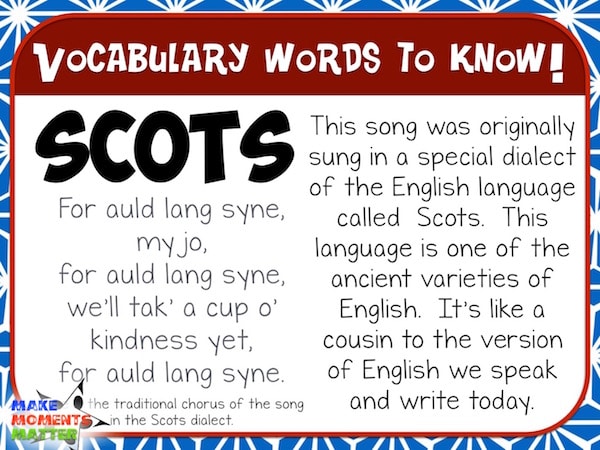 The most obvious phrase that you’re going to want to talk about is “Auld Lang Syne.” “Auld Lang Syne” is a Scots phrase that basically translates to “days long ago” or “days gone by.” In this song we’re asking if we should forget old friends or days that have already happened. This leads to an even more interesting conversation about language and dialect and how the English language has changed over the years. Kids don’t think about that very often (neither do adults, frankly) and this is a fun idea to bring up to them. I make sure to show them this slide about the “Scots” dialect and I even try to sing the first verse in Scots. They usually laugh at this.
The most obvious phrase that you’re going to want to talk about is “Auld Lang Syne.” “Auld Lang Syne” is a Scots phrase that basically translates to “days long ago” or “days gone by.” In this song we’re asking if we should forget old friends or days that have already happened. This leads to an even more interesting conversation about language and dialect and how the English language has changed over the years. Kids don’t think about that very often (neither do adults, frankly) and this is a fun idea to bring up to them. I make sure to show them this slide about the “Scots” dialect and I even try to sing the first verse in Scots. They usually laugh at this.
Kids often don’t realize that languages change, and so one thing that I do sometimes is really drop into some older English phrasing like you might find in the King James Version of the Bible or Shakespeare. Lots of “thee” and “thou” and “shall.” Kids usually understand what I’m saying even though I’m not using words that they really know. Or I might try and speak with an Australian accent and throw in some Australian phrases and vocabulary (which I do pretty terribly even though I studied abroad there years ago). It’s fun to draw comparisons and give some examples to kids of English used in ways that they are not familiar with.
Another important vocabulary word to talk about is acquaintance. This is not a word that they hear frequently, though they might know the general meaning. I explain it like this: “An acquaintance is someone you know. Someone you don’t know is a stranger. When you meet a stranger and get to know them they become an acquaintance. If you learn lots about them and learn to like them they become a friend. Stranger —> Acquaintance —> Friend.” It’s so easy to stop and take just a minute to explain this new word. It helps to expand the students’ vocabulary and gives them more ownership of the song. They’re not just singing a word or phrase “just because,” they’re singing it because the word has an important part in the song.
Additional Verses – It’s easy to teach them all!
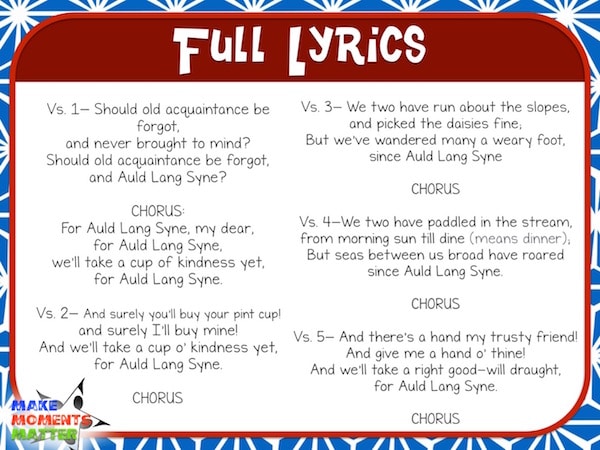 A year or two ago I took some time to do some research on this fun folk song and eventually turned it into a “Favorite Carol” set. As I was looking up the backstory and historical context for this song I found out that it had several verses that I’d never head before. As you can imagine, this song has been sung in more than one tavern. Let’s be honest, if people are singing it at the end of the night on New Year’s Eve, then it doesn’t take a tavern setting for “festive drink” to be involved. You might want to leave out a reference or two, even though they only speak of “pint cups” and “draught.” A quick swap out of words is easy to do!
A year or two ago I took some time to do some research on this fun folk song and eventually turned it into a “Favorite Carol” set. As I was looking up the backstory and historical context for this song I found out that it had several verses that I’d never head before. As you can imagine, this song has been sung in more than one tavern. Let’s be honest, if people are singing it at the end of the night on New Year’s Eve, then it doesn’t take a tavern setting for “festive drink” to be involved. You might want to leave out a reference or two, even though they only speak of “pint cups” and “draught.” A quick swap out of words is easy to do!
That being said, I really enjoy the other verses. If you want to introduce these new verses you could do a couple things. One really easy thing to do would be to quickly go through and sing the verses for the kids. You could project the words as you sing the verses and then have students join in on the chorus. That would keep them engaged and significantly speed up the learning process. Or you could divide students into groups and have each small group be in charge of singing one of the verses. Give them a minute or two to figure out how the words would match up with the melody. Then when it’s time to “perform out” for the class, you could sing along with each group on their verse and have the whole class join in on the chorus.
The Folk Dance – Fun for Everyone
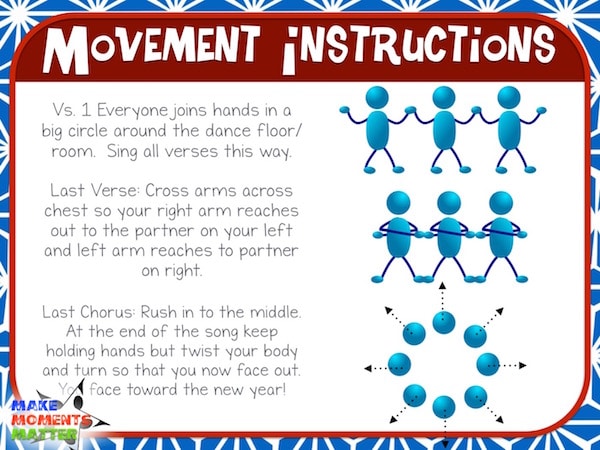 I have never personally done this dance at a party, but you had better believe that I’m going to print out my “Favorite Carol” PowerPoint presentation to show to all my friends on NYE… or maybe I won’t. But I’ll definitely be teaching this dance to my students! The movements are actually quite easy and the kids think that it’s really, really fun! For verse one Everyone joins hands in a big circle around the dance floor/room. Sing all verses this way in a nice big circle. You can sing as many verses as you want, but on the last verse cross arms across your chest so your right arm reaches out to the partner on your left and left arm reaches to partner on right. At the end of the song keep holding hands but twist your body and turn so that you now face out. You face toward the new year! Super fun symbolism and super easy dance moves!
I have never personally done this dance at a party, but you had better believe that I’m going to print out my “Favorite Carol” PowerPoint presentation to show to all my friends on NYE… or maybe I won’t. But I’ll definitely be teaching this dance to my students! The movements are actually quite easy and the kids think that it’s really, really fun! For verse one Everyone joins hands in a big circle around the dance floor/room. Sing all verses this way in a nice big circle. You can sing as many verses as you want, but on the last verse cross arms across your chest so your right arm reaches out to the partner on your left and left arm reaches to partner on right. At the end of the song keep holding hands but twist your body and turn so that you now face out. You face toward the new year! Super fun symbolism and super easy dance moves!
In the Favorite Carol kit that I created I’ve included a visual to help map out the dance and also some links to videos/media online that you could show to students. Try as I might I couldn’t find a video that showed the “turn out” at the end of the song but there are lots of videos of people in kilts singing, dancing, and having fun with arms crossed in a huge circle. If you watch a few videos you’ll find that the song goes pretty slowly at first but on the last verse they really speed up and have fun with the song!
I hope that this blog post gave you some new and different ideas to use when teaching this great song. You could teach Auld Lang Syne before or after your winter break and it would fit in really easily! In fact, you could teach the song before the break and use this as your “welcome back to school” song when you see kids in January. Please leave a comment below if you have any other ideas or suggestions when teaching this old favorite! I’d love to hear how you use this in your classroom!


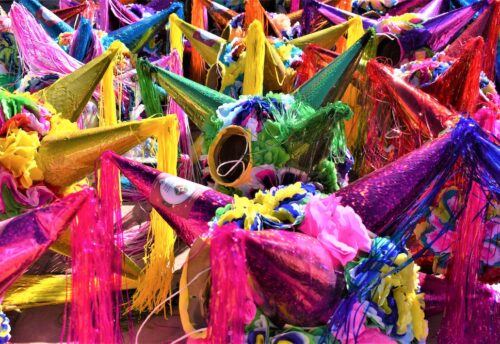
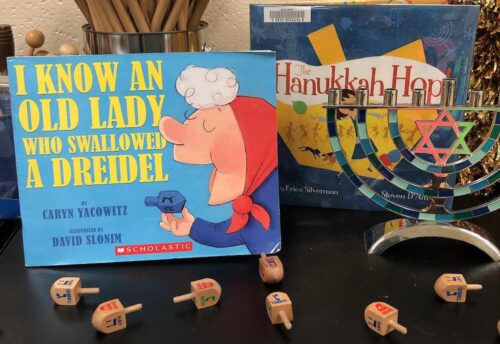
Pingback: An American Girl Christmas - Holiday Homeschool - Fields of Daisies